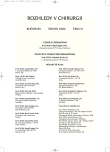Surgical Treatment Method of Calcaneal Intraarticular Fractures
Operační metoda léčby nitrokloubních zlomenin patní kosti
Otevřená repozice a vnitřní fixace nitrokloubních zlomenin patní kosti je dnes již standardní operační metoda, stále však diskutovaná v otázce obávaných komplikací, zejména sekundárního hojení rány a následné osteomyelitidy. Cílem této práce je seznámení chirurgické veřejnosti s touto operační metodou léčby.
V období od února 2004 do září 2005 bylo operováno 26 nitrokloubních zlomenin patní kosti u 22 pacientů otevřenou repozicí a vnitřní fixací dlahou. Čtyřikrát se jednalo o oboustrannou zlomeninu. Pacienti byli k operaci indikováni na základě Sandersovy CT klasifikace. Výkon byl prováděn rozšířeným laterálním přístupem tvaru L (Seattle), v anemizaci, za maximálního šetření měkkých tkání, doplněn spongioplastikou. U izolovaných dislokovaných zlomenin sustentakula byla provedena osteosyntéza z mediálního přístupu za použití šroubů. Po operaci končetina nebyla fixována, časně zahájena rehabilitace.
Téměř u všech operovaných pacientů kožní kryt zhojen primárně. U 3 pacientů se rána zhojila per secundam intentionem. U všech pacientů došlo podle RTG k plnému zhojení zlomeniny, bez uvolňování osteosyntetického materiálu, bez výraznějších známek subtalární artrózy či zhroucení nožní klenby. Hluboký infekt ani jiná závažná pooperační komplikace nebyla zaznamenána. Pacienti byli sledováni 6–22 měsíců a jsou nadále. Déle než 1 rok sledovaní pacienti jsou bez potíží, plně zatěžují operovanou končetinu a vrátili se k původnímu povolání.
Otevřenou repozici a interní stabilní fixaci dlahou autoři doporučují jako standardní metodu léčby u těchto zlomenin.
Klíčová slova:
nitrokloubní zlomeniny patní kosti – patní dlaha – osteosyntéza
Authors:
V. Rak; P. Buček; D. Ira; M. Mašek
Authors‘ workplace:
Klinika úrazové chirurgie FN Brno, přednosta kliniky doc. MUDr. M. Mašek, CSc.
Published in:
Rozhl. Chir., 2006, roč. 85, č. 6, s. 311-317.
Category:
Monothematic special - Original
Overview
Open repositioning and internal fixation of intraarticular calcaneal fractures has become a standard surgical method, however, concerns over its feared complications, including, in particular, secondary wound healing followed by osteomyelitis, continue fo be discussed. The aim of this study is to inform the surgical public about the surgical method.
From February 2004 to September 2005, 26 intraarticular calcaneal fractures in 22 patients were operated using open repositioning
and internal cast fixation. In four cases, the fracture was bilateral. The patients were indicated for the procedure based on the Sanders CT classification. The procedure included extensive L-shaped lateral approach (Seattle), anaemization, minimization of soft tissue disruption, and was followed by spongioplasty. In isolated dislocated sustentacular fractures, osteosynthesis through a medial approach was completed, using screws. Post-operatively, the extremity was not fixated and early rehabilitation was initiated.
In majority of the operated patients, the skin cover healed per primam. In 3 patients, the wound healed per secundam intentionem. Complete fracture healing was x-ray confirmed in all patients. No signs of the osteosynthetic material release or of pronounced signs of subtalar arthrosis or of a foot arch collapse were present. No deep defects or other serious postoperative complications were recorded. The follow-up period lasted for 6-22 months and goes on. The patients followed for over a year period have no symptoms, they fully wightbear the operated extremity and they have returned to their original professions.
Open repositioning and internal stable cast fixation is recommended as a standard treatment method in these fractures.
Key words:
intraarticular calcaneal fractures – calcaneal cast – osteosynthesis
Labels
Surgery Orthopaedics Trauma surgeryArticle was published in
Perspectives in Surgery

2006 Issue 6
- Metamizole vs. Tramadol in Postoperative Analgesia
- Current Insights into the Antispasmodic and Analgesic Effects of Metamizole on the Gastrointestinal Tract
- Spasmolytic Effect of Metamizole
- Metamizole at a Glance and in Practice – Effective Non-Opioid Analgesic for All Ages
Most read in this issue
- Hartmann’s Procedure – a Method Still Live
- Endoscopic Transgastric Drainage of a Pancreatic Pseudocyst – A Cause of Late Perforation of the Intestine
- Postintubation Stenosis of the Trachea – Case Reviews
- Spontaneous Pneumomediastinum
